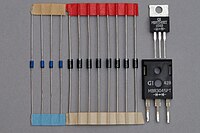
Photo from wikipedia
Two-dimensional silicon carbide (2d-SiC) is a viable material for next generation electronics due to its moderate, direct bandgap with huge potential. In particular, its potential for p-n junctions is yet… Click to show full abstract
Two-dimensional silicon carbide (2d-SiC) is a viable material for next generation electronics due to its moderate, direct bandgap with huge potential. In particular, its potential for p-n junctions is yet to be explored. In this paper, three types of 2d-SiC-based p-n junctions with different doping configuration are modeled. The doping configurations refer to partially replacing carbon with boron or nitrogen atoms along the zigzag or armchair direction, respectively. By employing density functional theory, we calculate the transport properties of the SiC based p-n junctions and obtain negative differential resistance and high rectification ratio. We also find that the junction along the zigzag direction with lower doping density exhibits optimized rectification performance. Our study suggests that 2d-SiC is a promising candidate as a material platform for future nano-devices.
Journal Title: Journal of Semiconductors
Year Published: 2017
Link to full text (if available)
Share on Social Media: Sign Up to like & get
recommendations!